Exogenous Calcium Improves Photosynthetic Capacity of Pinus sylvestris var. mongolica under Drought
Abstract
1. Introduction
2. Materials and Methods
2.1. Experimental Design and Plant Growth Conditions
2.2. Gas Exchange
2.3. Chlorophyll (Chl) a Fluorescence Measurement
2.4. Statistical Analysis
3. Results
4. Discussion and Conclusions
Author Contributions
Funding
Data Availability Statement
Conflicts of Interest
References
- Jiao, S.R. Report on the causes of the early decline of Pinus sylvestris var. mongolica shelterbelt and its preventative and control measures in Zhanggutai of Liaoning province. Sci. Silvae Sin. 2001, 37, 131–138. [Google Scholar]
- Jiang, F.Q.; Zeng, D.H.; Zhu, J.J. Fundamentals and technical strategy for sand-fixation forest management. Chin. J. Desert Res. 1997, 17, 250–254. [Google Scholar]
- Song, L.N.; Zhu, J.J.; Yan, Q.L.; Li, M.C.; Yu, G.Q. Comparison of intrinsic water use efficiency between different aged Pinus sylvestris var. mongolica windbreaks in semiarid sandy land of northern China. Agroforest. Syst. 2015, 89, 477–489. [Google Scholar] [CrossRef]
- Zhu, J.J.; Fan, Z.P.; Zeng, D.H.; Jiang, F.Q.; Matsuzaki, T. Comparison of stand structure and growth between artificial and natural forests of Pinus sylvestris var. mongolica on sandy land. J. For. Res. 2013, 14, 103–111. [Google Scholar]
- Neto, M.L.; Cerqueira, J.V.A.; Cunha, J.R.; Ribeiro, R.V.; Silveira, J.A.G. Cyclic electron flow, NPQ and photorespiration are crucial for the establishment of young plants of Ricinus communis and Jatropha curcas exposed to drought. Plant Boil. 2017, 19, 650–659. [Google Scholar] [CrossRef]
- Xu, Z.; Zhou, G. Responses of leaf stomatal density to water status and its relationship with photosynthesis in a grass. J. Exp. Bot. 2008, 59, 3317–3325. [Google Scholar] [CrossRef]
- Lu, C.; Zhang, J. Effects of waters stress on Photosystem II photochemistry and its thermostability in wheat plants. J. Exp. Bot. 1999, 336, 1199–1206. [Google Scholar] [CrossRef]
- Skotnica, J.; Matouškova, M.; Nauš, J.; Lazár, D.; Dvořák, L. Thermoluminescence and fluorescence study of changes in Photosystem II photochemistry in desiccating barley leaves. Photosynth. Res. 2000, 1, 29–40. [Google Scholar] [CrossRef] [PubMed]
- Kannan, N.D.; Kulandaivelu, G. Drought induced changes in physiological, biochemical and phytochemical properties of Withania somnifera Dun. J. Med. Plants Res. 2011, 5, 3929–3935. [Google Scholar]
- Kalaji, H.M.; Jajoo, A.; Oukarroum, A.; Brestic, M.; Zivcak, M.; Samborska, I.A.; Cetner, M.S.; Łukasik, I.; Goltsev, V.; Ladle, R.J. Chlorophyll a fluorescence as a tool to monitor physiological status of plants under abiotic stress conditions. Acta Physiol. Plant. 2016, 38, 1–11. [Google Scholar] [CrossRef]
- Zhang, S.B.; Huang, W.; Zhang, J.L.; Cao, K.F. Differential responses of photosystems I and II to seasonal drought in two Ficus cultivars. Acta Oecol. 2016, 73, 53–60. [Google Scholar] [CrossRef]
- Zivcak, M.; Brestic, M.; Balatova, Z.; Drevenakova, P.; Olsovska, K.; Kalaji, M.H.; Allakhverdiev, S.I. Photosynthetic electron transport and specific photoprotective responses in wheat leaves under drought stress. Photosynth. Res. 2013, 117, 529–546. [Google Scholar] [CrossRef]
- Müller, P.; Li, X.P.; Niyogi, K.K. Non-photochemical quenching: A response to excess light energy. Plant Physiol. 2001, 125, 1558. [Google Scholar] [CrossRef]
- Oukarroum, A.; Schansker, G.; Strasser, R.J. Drought stress effects on photosystem I content and photosystem II thermotolerance analyzed using Chl a fluorescence kinetics in barley varieties differing in their drought tolerance. Physiol. Plant. 2009, 137, 188–199. [Google Scholar] [CrossRef] [PubMed]
- Pei, Z.M.; Ghassemian, M.; Kwak, C.M.; McCourt, P.; Schroeder, J.I. Role of farnesyl transferase in ABA regulation of guard cell anion channels and plant water loss. Science 1998, 282, 287–290. [Google Scholar] [CrossRef] [PubMed]
- Pei, Z.M.; Murata, Y.; Benning, G.; Thomine, S.; Klüsener, B.; Allen, G.J.; Grill, E.; Schroeder, J.I. Calcium channels activated by hydrogen peroxide mediate abscisic acid signalling in guard cells. Nature 2000, 406, 731–734. [Google Scholar] [CrossRef]
- Hepler, P.K. Calcium, a central regulator of plant growth and development. Plant Cell 2005, 17, 2142–2155. [Google Scholar] [CrossRef] [PubMed]
- Reddy, A.S.; Ali, G.S.; Celesnik, H.; Day, I.S. Coping with stresses: Roles of calcium and calcium/calmodulin-regulated gene expression. Plant Cell 2011, 23, 2010–2032. [Google Scholar] [CrossRef]
- Popelkova, H.; Boswell, N.; Yocum, C. Probing the topography of the photosystem II oxygen evolving complex: PsbO is required for efficient calcium protection of the manganese cluster against dark-inhibition by an artificial reductant. Photosynth. Res. 2011, 110, 111–121. [Google Scholar] [CrossRef]
- Tyryshkin, A.M.; Watt, R.K.; Baranov, S.V.; Dasgupta, J.; Hendrich, M.P.; Dismukes, G.C. Spectroscopic evidence for Ca2+ involvement in the assembly of the Mn4Ca cluster in the photosynthetic water-oxidizing complex. Biochemistry 2006, 45, 12876–12889. [Google Scholar] [CrossRef] [PubMed]
- Hochmal, A.K.; Schulze, S.; Trompelt, K.; Hippler, M. Calcium-dependent regulation of photosynthesis. BBA-Bioenerg. 2015, 1847, 993–1003. [Google Scholar] [CrossRef] [PubMed]
- Kukuczka, B.; Magneschi, L.; Petroutsos, D.; Steinbeck, J.; Bald, T.; Powikrowska, M.; Fufezan, C.; Finazzi, G.; Hippler, M. Proton Gradient Regulation5-Like1-Mediated Cyclic Electron Flow Is Crucial for Acclimation to Anoxia and Complementary to Nonphotochemical Quenching in Stress Adaptation. Plant Physiol. 2014, 165, 1604–1617. [Google Scholar] [CrossRef] [PubMed]
- Wang, Q.; Yang, S.; Wan, S.; Li, X. The Significance of Calcium in Photosynthesis. Int. J. Mol. Sci. 2019, 20, 1353. [Google Scholar] [CrossRef] [PubMed]
- White, P.J. The pathways of calcium movement to the xylem. J. Exp. Bot. 2001, 52, 891. [Google Scholar] [CrossRef] [PubMed]
- White, P.J.; Broadley, M.R. Calcium in Plants. Ann. Bot. 2003, 92, 487–511. [Google Scholar] [CrossRef]
- Xu, C.; Li, X.; Zhang, L. The effect of calcium chloride on growth, photosynthesis, and antioxidant responces of Zoysia japonica under drought conditions. PLoS ONE 2013, 8, e68214. [Google Scholar]
- Jaleel, C.A.; Manivannan, P.; Sankar, B.; Kishorekumar, A.; Gopi, R.; Somasundaram, R.; Panneerselvam, R. Water deficit stress mitigation by calcium chloride in Catharanthus roseus: Effect on oxidative stress, proline metabolism and indole alkaloid accumulation. Colloids Surf. B 2007, 60, 110–116. [Google Scholar] [CrossRef] [PubMed]
- Khushboo; Kritika, B.; Preeti, S.; Meenakshi, R.; Vinay, S.; Deepak, K. Exogenous application of calcium chloride in wheat genotypes alleviates negative effect of drought stress by modulating antioxidant machinery and enhanced osmolyte accumulation. In Vitro Cell. Dev.-Plant 2018, 54, 495–507. [Google Scholar] [CrossRef]
- Stirbet, A.; Lazár, D.; Kromdijk, J.; Govindjee, G. Chlorophyll fluorescence induction: Can just a one second measurement be used to quantify a biotic stress response? Photosynthetica 2018, 1, 86–104. [Google Scholar] [CrossRef]
- Murchie, E.H.; Lawson, T. Chlorophyll fluorescence analysis: A guide to good practice and understandings new applications. J. Exp. Bot. 2013, 13, 3983–3998. [Google Scholar] [CrossRef]
- Mehta, P.; Allakhverdiev, S.I.; Jajoo, A. Characterization of photosystem II heterogeneity in response to high salt stress in wheat leaves (Triticum aestivum). Photosynth. Res. 2010, 105, 249–255. [Google Scholar] [CrossRef]
- Gururani, M.A.; Upadhyaya, C.P.; Strasser, R.J.; Yu, J.W.; Park, S.W. Evaluation of abiotic stress tolerance in transgenic potato plants with reduced expression of PSII manganese stabilizing protein. Plant Sci. 2013, 198, 7–16. [Google Scholar] [CrossRef] [PubMed]
- Gururani, M.A.; Venkatesh, J.; Ganesan, M.; Strasser, R.J.; Han, Y.J.; Kim, J.I.; Lee, H.Y.; Song, P.S. In vivo assessment of cold tolerance through chlorophyll-a fluorescence in transgenic zoysia grass expressing mutant phytochrome A. PLoS ONE 2015, 10, e0127200. [Google Scholar] [CrossRef] [PubMed]
- Simeneh, T.A. Photosynthesis limiting stresses under climate change scenarios and role of chlorophyll fluorescence: A review article. Cogent Food Agric. 2020, 6, 1785136. [Google Scholar]
- Öz, M.T.; Turan, Ö.; Kayihan, C.; Eyidoğan, F.; Ekmekçi, Y.; Yücel, M.; Öktem, H.A. Evaluation of photosynthetic performance of wheat cultivars exposed to boron toxicity by the JIP fluorescence test. Photosynthetica 2014, 52, 555–563. [Google Scholar] [CrossRef]
- Stirbet, A. On the relation between the Kautsky effect (chlorophyll a fluorescence induction) and Photosystem II: Basics and applications of the OJIP fluorescence transient. J. Photochem. Photobiol. B 2011, 104, 236–257. [Google Scholar] [CrossRef]
- Paillotin, G. Movement of excitations in the photosynthetic domains of photosystem I. J Theor. Biol. 1976, 58, 337–352. [Google Scholar] [CrossRef]
- Strasser, R.J. The grouping model of plant photosynthesis: Heterogeneity of photosynthetic units in thy-lakoids. In Structure and Molecular Organisation of the Photosynthetic Apparatus, Photosynthesis, Proceedings of the Vth International Congress on Photosynthesis; Akoyunoglou, G., Ed.; Balaban International Science Services: Philadelphia, PA, USA, 1981; Volume III, pp. 727–737. [Google Scholar]
- Strasser, R.J.; Tsimilli-Michael, M.; Qiang, S.; Goltsev, V. Simultaneous in vivo recording of prompt and delayed fluorescence and 820-nm reflection changes during drying and after rehydration of the resurrection plant Haberlea rhodopensis. Biochim. Biophys. Acta 2010, 1797, 1313–1326. [Google Scholar] [CrossRef]
- Strasser, R.J.; Srivastava, A.; Govindjee, G. Polyphasic chlorophyll a fluorescence transient in plants and cyanobacteria. Photochem. Photobiol. 1995, 61, 32–42. [Google Scholar] [CrossRef]
- Strasser, R.J.; Tsimilli-Michael, M.; Srivastava, A. Analysis of the fluorescence transient. In Chorophyll Fluorescence: A Signature of Photosynthesis. Advances in Photosynthesis and Respiration Series; Papageorgiou, G.C., Govindjee, Eds.; Springer: Dordrecht, The Netherlands, 2004; pp. 321–362. [Google Scholar]
- Strasser, B.J.; Strasser, R.J. Measuring Fast Fluorescence Transients to Address Environmental Questions: The JIP-Test. In Photosynthesis: From Light to Biosphere; Mathis, P., Ed.; Kluwer Acadamic Publishers: Dordrecht, The Netherlands, 1995; Volume V, pp. 977–980. [Google Scholar]
- Zhang, N.; Xu, X.; Wu, J.; Wang, S.; Ma, X.; Li, G.; Sun, G. Effects of four types of sodium salt stress on plant growth and photosynthetic apparatus in sorghum leaves. J. Plant Interact. 2018, 13, 506–513. [Google Scholar] [CrossRef]
- Li, Y.; Li, H.; Li, Y.; Zhang, S. Improving water-use efficiency by decreasing stomatal conductance and transpiration rate to maintain higher ear photosynthetic rate in drought-resistant wheat. Crop. J. 2017, 5, 231–239. [Google Scholar] [CrossRef]
- Ashraf, M.; Harris, P.J.C. Photosynthesis under stressful environments: An overview. Photosynthetica 2013, 51, 163–190. [Google Scholar] [CrossRef]
- Strasser, B.J. Donor side capacity of photosystem II probed by chlorophyll a fluorescence transients. Photosynth. Res. 1997, 52, 147–155. [Google Scholar] [CrossRef]
- Xin, C.P.; Yang, J.; Zhu, X.G. A model of chlorophyll a fluorescence induction kinetics with explicit description of structural constraints of individual photosystem II units. Photosynth. Res. 2013, 117, 339–354. [Google Scholar] [CrossRef]
- Henmi, T.; Miyao, M.; Yamamoto, Y. Release and reactive-oxygen-mediated damage of the oxygen-evolving complex subunits of PSII during photoinhibition. Plant Cell Physiol. 2004, 45, 243–250. [Google Scholar] [CrossRef]
- Nishiyama, Y.; Yamamoto, H.; Allakhverdiev, S.I.; Inaba, M.; Yokota, A.; Murata, N. Oxidative stress inhibits the repair of photodamage to the photosynthetic machinery. EMBO J. 2014, 20, 5587–5594. [Google Scholar] [CrossRef]
- Yang, S.; Wang, F.; Guo, F.; Meng, J.J.; Li, X.G.; Dong, S.T.; Wan, S.B. Exogenous calcium alleviates photoinhibition of PSII by improving the xanthophyll cycle in peanut (Arachis Hypogaea) leaves during heat stress under high irradiance. PLoS ONE 2013, 8, e71214. [Google Scholar] [CrossRef]
- Yang, S.; Wang, F.; Guo, F.; Meng, J.J.; Li, X.G.; Wan, S.B. Calcium contributes to photoprotection and repair of photosystem II in peanut leaves during heat and high irradiance. J. Integr. Plant Biol. 2015, 57, 486–495. [Google Scholar] [CrossRef]
- Li, Z.L.; Burnap, R.L. Mutations of Arginine 64 within the putative Ca2+-binding lumenal interhelical a-b loop of the photosystem II D1 protein disrupt binding of the manganese stabilizing protein and cytochrome c550 in Synechocystis sp. PCC6803. Biochemistry 2001, 40, 10350–10359. [Google Scholar] [CrossRef]
- Guo, Y.Y.; Lia, H.J.; Liu, J.; Bai, Y.W.; Xue, J.Q.; Zhang, R.H. Melatonin Alleviates Drought-Induced Damage of Photosynthetic Apparatus in Maize Seedlings. Russ. J. Plant Physiol. 2020, 67, 312–322. [Google Scholar] [CrossRef]
- Gao, J.; Li, P.M.; Ma, F.W.; Goltsev, V. Photosynthetic performance during leaf expansion in Malus micromalus probed by chlorophyll a fluorescence and modulated 820 nm reflection. J. Photochem. Photobiol. B 2014, 137, 144–150. [Google Scholar] [CrossRef] [PubMed]
- Gomes, M.T.G.; da Luz, A.C.; dos Santos, M.R.; Batitucci, M.D.C.P.; Silva, D.M.; Falqueto, A.R. Drought tolerance of passion fruit plants assessed by the OJIP chlorophyll a fluorescence transient. Sci. Hortic. 2012, 142, 49–56. [Google Scholar] [CrossRef]
- Liu, J.; Li, H.J.; Guo, Y.Y.; Wang, G.X.; Zhang, H.J.; Zhang, R.H.; Xu, W.H. Responses of Photosynthetic Electron Transport to Drought and Re-watering in Two Maize Genotypes. Russ. J. Plant Physiol. 2020, 67, 912–922. [Google Scholar] [CrossRef]
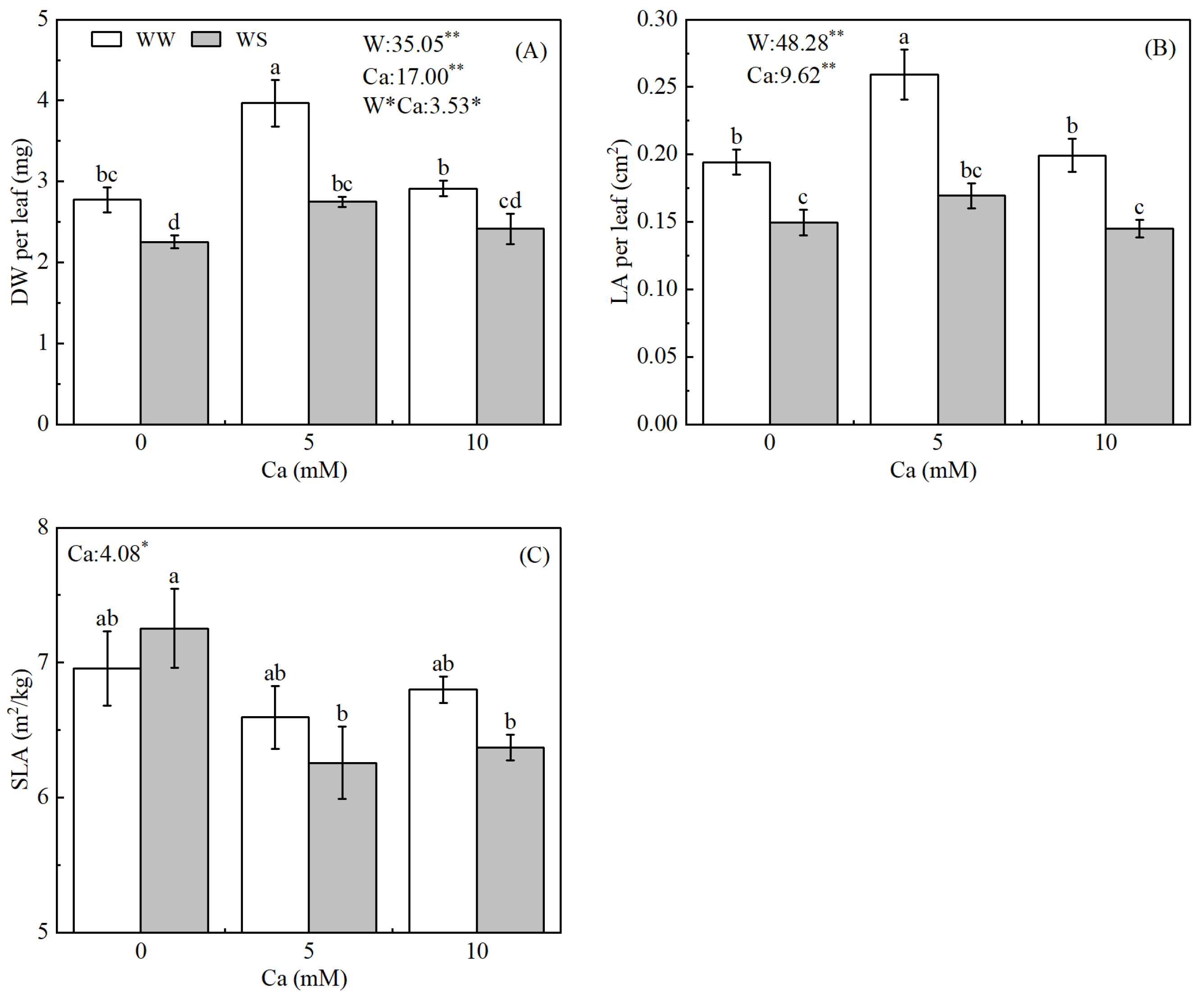
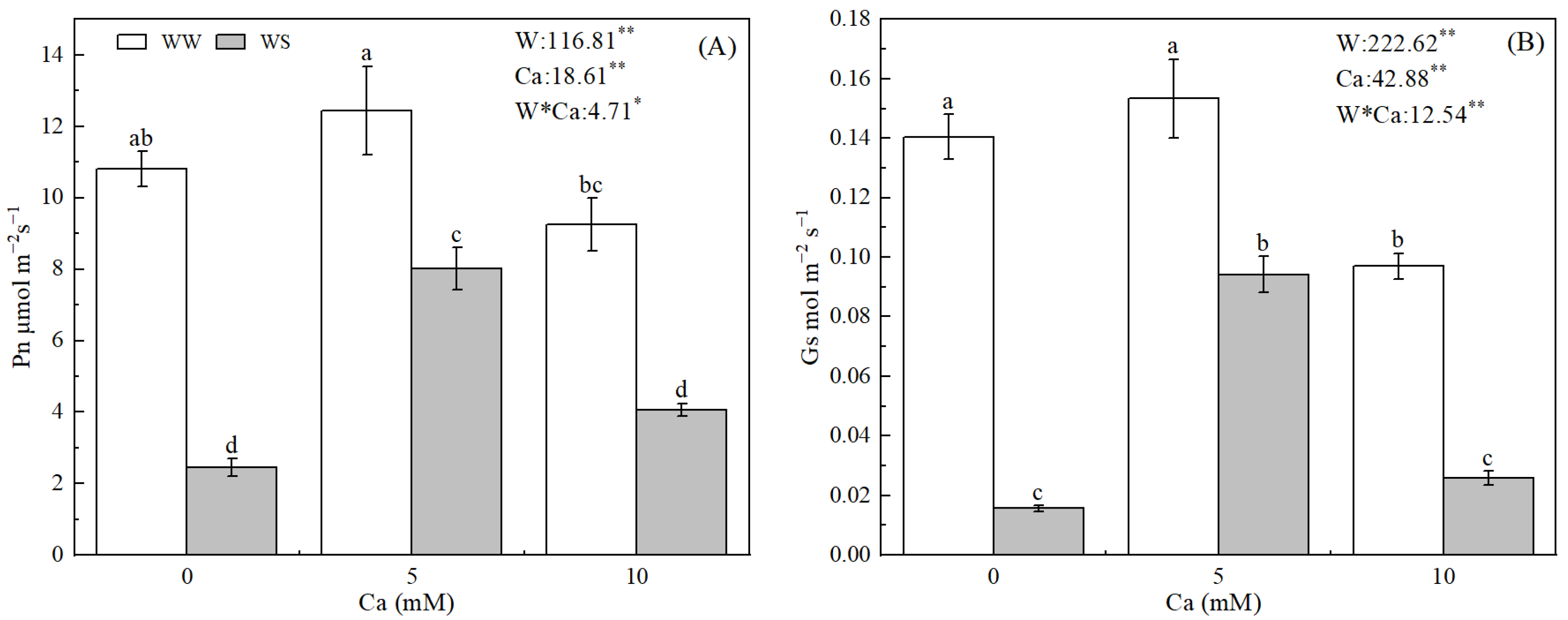
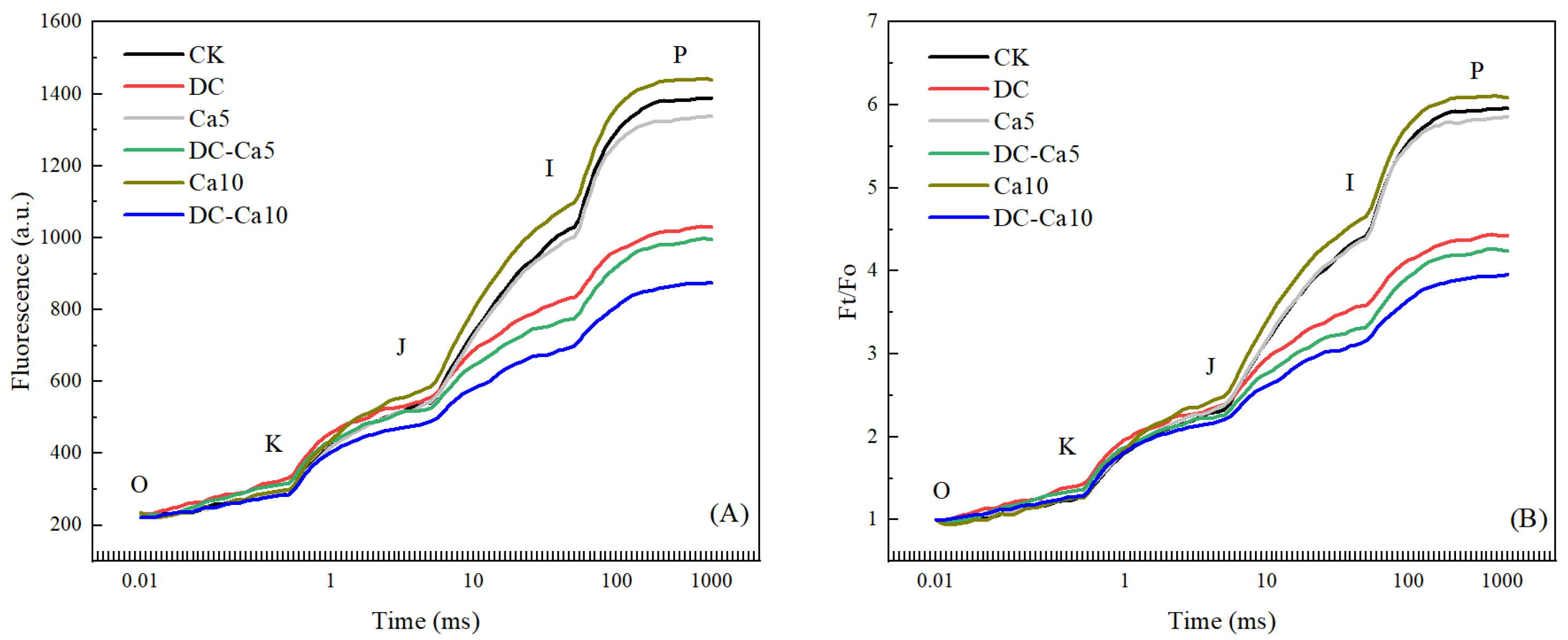
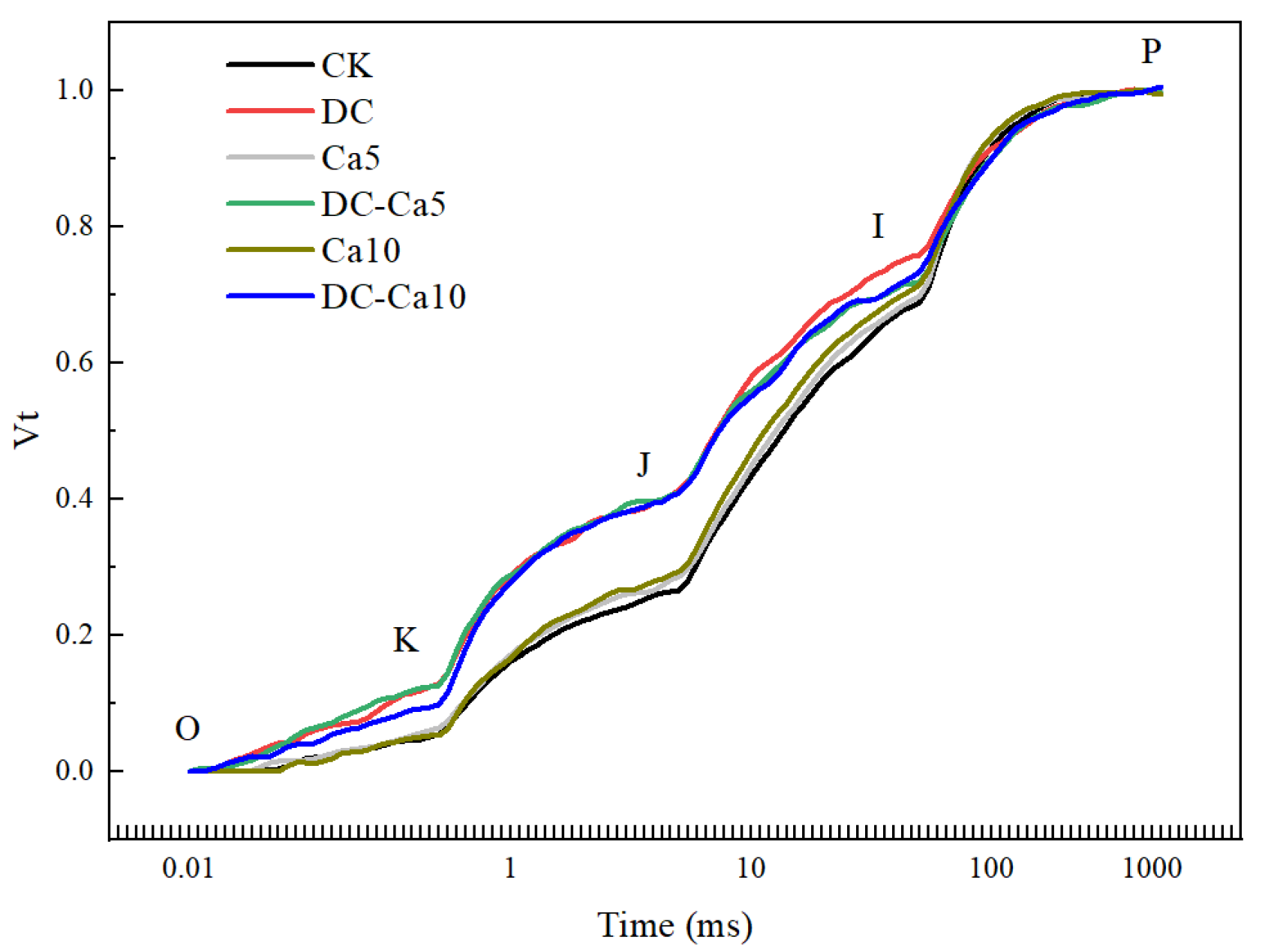
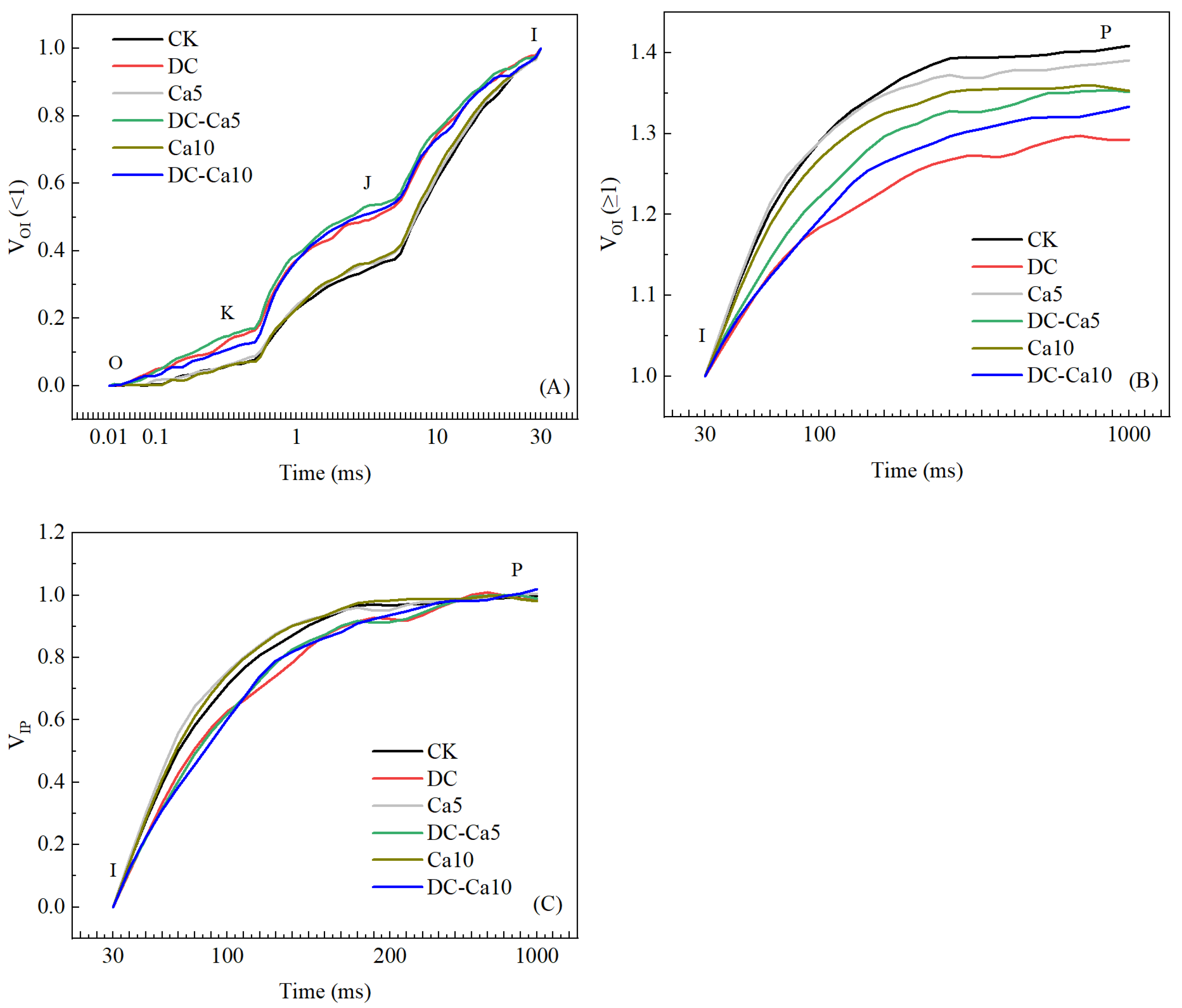
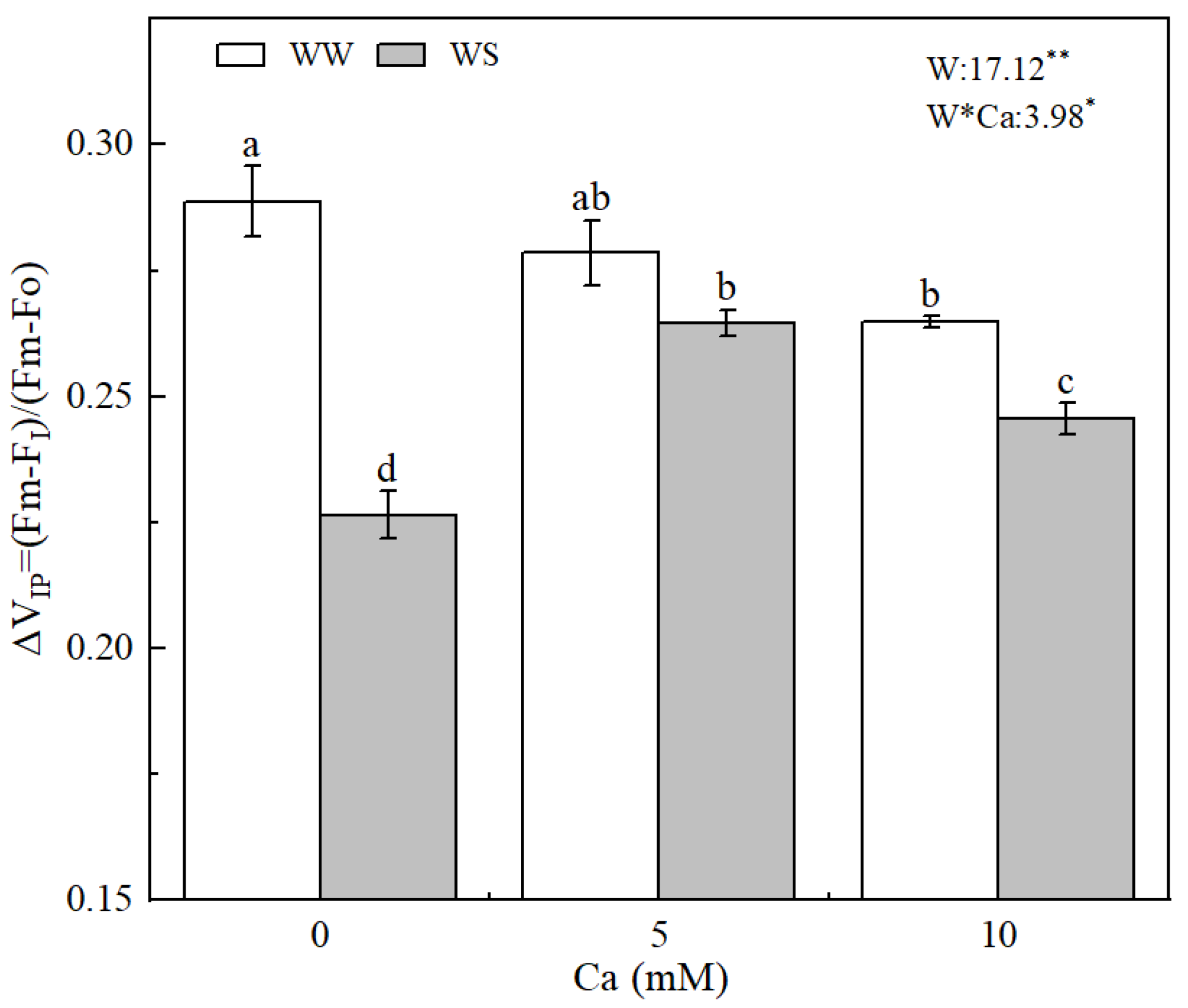
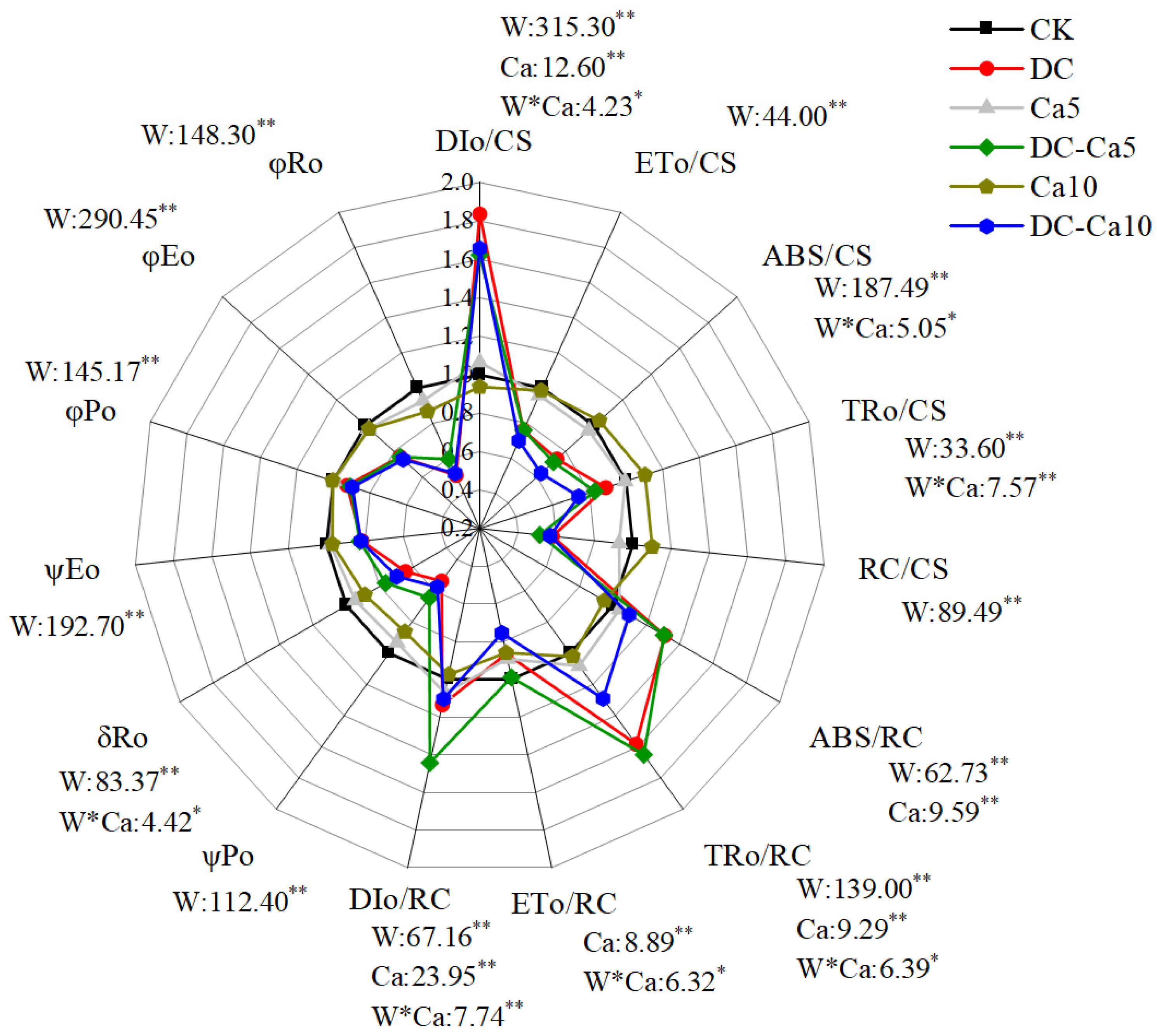
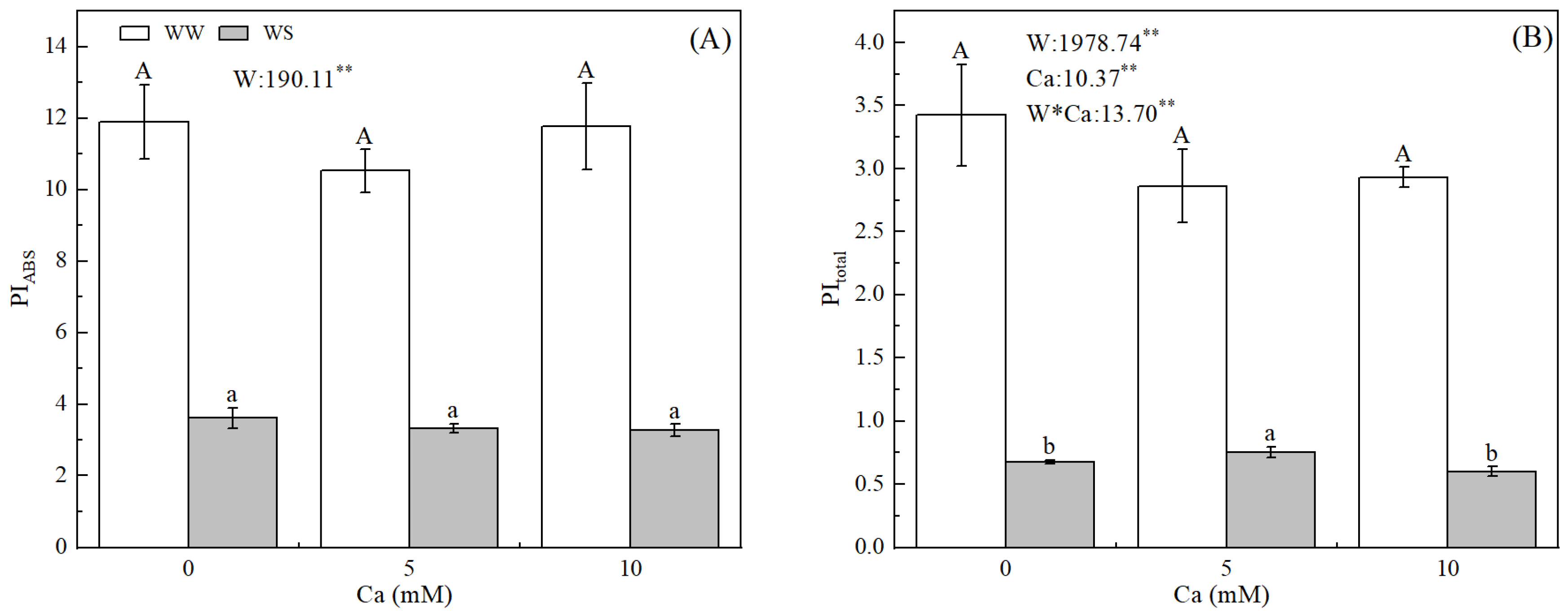
| Fo | Fm | Sm | VJ | VI | Mo | |||||||
|---|---|---|---|---|---|---|---|---|---|---|---|---|
| CK | 233.00 ± 5.57 b | 1390.67 ± 45.32 a | 27.13 ± 0.63 a | 0.23 ± 0.00 b | 0.71 ± 0.01 b | 0.27 ± 0.02 c | ||||||
| DC | 259.50 ± 3.18 a | 1030.33 ± 35.33 b | 21.62 ± 1.02 b | 0.37 ± 0.04 a | 0.77 ± 0.02 a | 0.54 ± 0.03 a | ||||||
| Ca5 | 228.33 ± 9.84 b | 1338.33 ± 91.55 a | 27.13 ± 0.96 a | 0.24 ± 0.01 b | 0.72 ± 0.02 b | 0.30 ± 0.01 c | ||||||
| DC-Ca5 | 232.00 ± 9.87 b | 996.00 ± 6.11 b | 26.74 ± 1.46 a | 0.36 ± 0.05 a | 0.74 ± 0.02 b | 0.46 ± 0.01 b | ||||||
| Ca10 | 235.33 ± 9.96 b | 1442.67 ± 64.24 a | 24.07 ± 1.44 ab | 0.25 ± 0.02 b | 0.74 ± 0.00 b | 0.29 ± 0.01 c | ||||||
| DC-Ca10 | 221.67 ± 2.19 b | 874.33 ± 39.82 c | 25.90 ± 0.49 a | 0.37 ± 0.00 a | 0.75 ± 0.01 b | 0.43 ± 0.02 b | ||||||
| Fo | Fm | Sm | VJ | VI | Mo | |||||||
| F | P | F | P | F | P | F | P | F | P | F | P | |
| W | 0.80 | 0.39 | 154.83 | 0.00 | 8.08 | 0.02 | 34.30 | 0.00 | 19.81 | 0.00 | 371.08 | 0.00 |
| Ca | 3.40 | 0.07 | 0.89 | 0.60 | 10.45 | 0.00 | 0.07 | 0.93 | 2.03 | 0.17 | 7.99 | 0.01 |
| W*Ca | 3.60 | 0.06 | 4.54 | 0.03 | 20.71 | 0.00 | 0.17 | 0.84 | 4.61 | 0.03 | 16.12 | 0.00 |
Publisher’s Note: MDPI stays neutral with regard to jurisdictional claims in published maps and institutional affiliations. |
© 2022 by the authors. Licensee MDPI, Basel, Switzerland. This article is an open access article distributed under the terms and conditions of the Creative Commons Attribution (CC BY) license (https://creativecommons.org/licenses/by/4.0/).
Share and Cite
Li, Y.; Fang, A.; Zhang, T.; Zhang, S.; Zhu, W.; Zhou, Y. Exogenous Calcium Improves Photosynthetic Capacity of Pinus sylvestris var. mongolica under Drought. Forests 2022, 13, 2155. https://doi.org/10.3390/f13122155
Li Y, Fang A, Zhang T, Zhang S, Zhu W, Zhou Y. Exogenous Calcium Improves Photosynthetic Capacity of Pinus sylvestris var. mongolica under Drought. Forests. 2022; 13(12):2155. https://doi.org/10.3390/f13122155
Chicago/Turabian StyleLi, Yanan, Anqi Fang, Tengzi Zhang, Songzhu Zhang, Wenxu Zhu, and Yongbin Zhou. 2022. "Exogenous Calcium Improves Photosynthetic Capacity of Pinus sylvestris var. mongolica under Drought" Forests 13, no. 12: 2155. https://doi.org/10.3390/f13122155
APA StyleLi, Y., Fang, A., Zhang, T., Zhang, S., Zhu, W., & Zhou, Y. (2022). Exogenous Calcium Improves Photosynthetic Capacity of Pinus sylvestris var. mongolica under Drought. Forests, 13(12), 2155. https://doi.org/10.3390/f13122155






